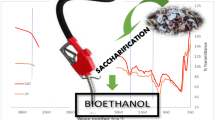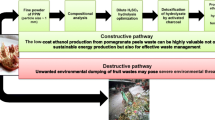Abstract
Vodka is a transparent distilled alcoholic beverage, obtained by fermenting various substrates such as cereal grains, potatoes, and molasses, offering economic viability and widespread availability. A bioprocess for vodka production was optimized using potato waste collected from Iscon Balaji Foods Pvt. Ltd. Ladhowal, comprising of potato peel, mash, and industrial water. The proximate and physicochemical analysis showed high starch content (59%) and rich organic constituents in potato peel and mash mixture. The response surface methodology was used to optimize liquefaction with α-amylase (5000 IU/mL/min) dose of 0.72% (v/v) for 62.15 min at 59.8 °C and saccharification with glucoamylase (1000 IU/mL/min) dose of 1.7% (v/v) for 28.5 h at 52 °C. The concentration of fermentable sugars in the wort before fermentation was 13.03 mg/mL of total sugars and 10.69 mg/mL of reducing sugars. The ethanol fermentation was carried out by inoculating Saccharomyces cerevisiae (MK680910) at the pitching rate of 6% and after 3 days of fermentation the alcohol content of 7.6% (v/v) was recorded in potato waste mixture. Subsequent fractional distillation at 80 °C resulted in ethanol concentration of 38.4% with 76.8° proof. Hence, this study presents an efficient method for fermentative processing of potato waste into vodka.



Similar content being viewed by others
References
Wu T, Yan J, Liu R, Marcone MF, Aisa HA, Tsao R (2012) Optimization of microwave-assisted extraction of phenolics from potato and its downstream waste using orthogonal array design. Food Chem 133:1292–1298. https://doi.org/10.1016/j.foodchem.2011.08.002
Pathak PD, Mandavgane SA, Puranik NM, Jambhulkar SJ, Kulkarni BD (2018) Valorization of potato peel: a biorefinery approach. Crit Rev Biotechnol 38:218–230. https://doi.org/10.1080/07388551.2017.1331337
FAO (2021) Food and Agriculture Organization of the United Nations, FAOSTAT Statistical Database. https://www.fao.org/faostat/en/#data/QCL. Accessed 22 Nov 2023
Buckseth T, Tiwari JK, Singh RK, Kumar V, Sharma AK, Dalamu D, Bhardwaj V, Sood S, Kumar M, Sadawarti M, Challam C, Naik S, Pandey NK (2022) Advances in innovative seed potato production systems in India. Front Agron 4:1–7. https://doi.org/10.3389/fagro.2022.956667
Luthra V, Keshani, Kocher GS, Singh A (2024) Quality evaluation and Fourier transform infrared (FTIR) spectroscopy characterization of vodka produced from malted & un-malted potatoes using Saccharomyces cerevisiae (MK680910). Potato Research. https://doi.org/10.1007/s11540-024-09694-4
Abdelraof M, Hasanin MS, El-Saied H (2019) Ecofriendly green conversion of potato peel wastes to high productivity bacterial cellulose. Carbohydr Polym 211:75–83. https://doi.org/10.1016/j.carbpol.2019.01.095
Sharma S, Malhotra N, Singh A, Sharma R, Domínguez R, Lorenzo JM (2022) Modulation in techno-functional, textural properties, in vitro starch digestibility and macromolecular–structural interactions of pasta with potato (Solanum tuberosum L). Molecules 27:7835. https://doi.org/10.3390/molecules27227835
Singh L, Kaur S, Aggarwal P (2023) Enhanced functional and textural properties of waffle premix by addition of phytonutrient-rich industrial potato waste. Biomass Conv Bioref 13: 14789–14802 (2023). https://doi.org/10.1007/s13399-022-03246-x
Singh L, Kaur S, Aggarwal P, Kaur N (2023b) Characterisation of industrial potato waste for suitability in food applications. Int J Food Sci Technol 58(5):2686–2694. https://doi.org/10.1111/ijfs.16023
Hamami Z, Javanbakht V (2023) Photocatalytic processes using potato peel extract-mediated CuO nanophotocatalyst for fast and efficient direct red 80 dye removal. Biomass Convers Biorefinery. https://doi.org/10.1007/s13399-023-05034-7
Kot AM, Pobiega K, Piwowarek K, Kieliszek M, Błażejak S, Gniewosz M, Lipińska E (2020) Biotechnological methods of management and utilization of potato industry waste- a review. Potato Res 63:431–447. https://doi.org/10.1007/s11540-019-09449-6
Yamada S, Shinomiya N, Ohba K, Sekikawa M, Oda Y (2009) Enzymatic hydrolysis and ethanol fermentation of by-products from potato processing plant. Food Sci Technol Res 15:653–658. https://doi.org/10.3136/fstr.15.653
Singh L, Kaur S, Aggarwal P (2022) Techno and bio functional characterization of industrial potato waste for formulation of phytonutrients rich snack product. Food Bioscience 49:101824. https://doi.org/10.1016/j.fbio.2022.101824
Felekis V, Stavraki C, Malamis D, Mai S, Barampouti EM (2023) Optimisation of bioethanol production in a potato processing industry. Fermentation 9:103. https://doi.org/10.3390/fermentation9020103
Israilides C, Vlyssides AG, Arapoglou D, Varzakas T, Marchant R, Vlysides AA (2008) Integrated management of potato starch wastes. In: Proceedings of the Waste and Resource Management – A Shared Responsibility (Waste 2008), September 16–17, Stratford-Upon-Avon, UK, No. 36
Sanchez OJ, Cardona CA (2008) Trends in biotechnological production of fuel ethanol from different feedstocks. Bioresource Technol 99:5270–5295. https://doi.org/10.1016/j.biortech.2007.11.013
Tasic MB, Konstantinovic BV, Lazic ML, Veljkovic VB (2009) The acid hydrolysis of potato tuber mash in bioethanol production. Biochem Eng J 43:208–211. https://doi.org/10.1016/j.bej.2008.09.019
Ruiz MI, Sanchez CI, Torrres RG, Molina DR (2011) Enzymatic hydrolysis of cassava starch for production of bioethanol with a Colombian wild yeast strain. Braz Chem Soc 22:2337–2343. https://doi.org/10.1590/S0103-50532011001200014
Shanavas S, Padmaja G, Moorthy SN, Sajeev MS, Sheriff JT (2011) Process optimization for bioethanol production from cassava starch using novel eco-friendly enzymes. Biomass Bioenergy 35(2):901–909. https://doi.org/10.1016/j.biombioe.2010.11.004
Fadel M (2000) Alcohol production from potato industry starchy waste. Egypt J Microbiol 35:273–287
Lamidi S, Olaleye N, Bankole Y, Obalola A, Aribike E, Adigun I (2022) Applications of response surface methodology (RSM) in product design, development, and process optimization In Response surface methodology- Research advances and application. Palanikumar Kayarogannam (Ed.), Intech Open. https://doi.org/10.5772/intechopen.106763
Montgomery DC (2005) Design and analysis of experiments: response surface method and designs. John Wiley and Sons, Inc, New Jersey
Breig SJM, Luti KJK (2021) Response surface methodology: a review on its applications and challenges in microbial cultures. Mater Today: Proc 42: 2277–2284. https://doi.org/10.1016/j.matpr.2020.12.316
Yolmeh M, Jafari SM (2017) Applications of response surface methodology in the food industry processes. Food Bioprocess Technol 10(3):413–433
Bobade H, Singh A, Sharma S, Gupta A, Singh B (2022) Effect of extrusion conditions and honey on functionality and bioactive composition of whole wheat flour-based expanded snacks. J Food Process Preserv 46:e16132. https://doi.org/10.1111/jfpp.16132
Bansal R, Katyal P, Jain D (2022) Enzymatic and acidic hydrolysis of cull potatoes for production of fermentable sugars. Starch - Stärke 74:2100202. https://doi.org/10.1002/star.202100202
AACC (2000) Approved methods of American Association of Cereal Chemists. 10th Edn.The Association St. Paul, MN. https://doi.org/10.4236/sm.2023.134014
Clegg K (1956) The application of anthrone reagent to the estimation of starch in cereals. J Sci Food Agric 7:40–44. https://doi.org/10.1002/jsfa.2740070108
Dubois M, Gilles KA, Hamilton JK, Rebers PA, Smith F (1956) Colorimetric method for determination of sugars and related substances. Anal Chem 28:350–356. https://doi.org/10.1021/ac60111a017
Miller GL (1959) Use of dinitrosalicylic acid reagent for determination of reducing sugars. AnalChem 31:426–28. https://doi.org/10.1021/ac60147a030
Singh P, Kaur G, Singh A, Sharma T, Dar BN (2023) Improved mechanical, functional and antimicrobial properties of corn starch-based biodegradable nanocomposites films reinforced with lemongrass oil nanoemulsion and starch nano-crystal. Mater Chem Phys 308:128267. https://doi.org/10.1016/j.matchemphys.2023.128267
Sharma T, Kaur G, Singh A, Singh P (2023) Montmorillonite and chitosan modulates the techno-functional, mechanical, antibacterial, biodegradation and morphological characteristics of gluten-based nanocomposite films. J Food Meas Charact 17(6):5550–5568. https://doi.org/10.1007/s11694-023-02062-9
Azizi AF, Sethi S, Joshi A, Singh AM, Raigond P, Singh MK, Yadav RK (2020) Biochemical and functional attributes of raw and boiled potato flesh and peel powders for suitability in food applications. JFST 57:3955–3965. https://doi.org/10.1007/s13197-020-04424-3
Liang S, Han Y, Wei L et al (2015) Production and characterization of bio-oil and bio-char from pyrolysis of potato peel wastes. Biomass Convers Bior 5:237–246. https://doi.org/10.1007/s13399-014-0130-x
Akyol H, Riciputi Y, Capanoglu E, Caboni MF, Verardo V (2016) Phenolic compounds in the potato and its byproducts: an overview. Int J Mol Sci 17:835. https://doi.org/10.3390/ijms17060835
Javed A, Ahmad A, Tahir A, Shabbir U, Nouman M, Hameed A (2019) Potato peel waste its nutraceutical, industrial and biotechnological applications. AIMS Agric Food 4:3807–3823. https://doi.org/10.3934/agrfood.2019.3.807
Adeboye PT, Bettiga M, Olsson L (2014) The chemical nature of phenolic compounds determines their toxicity and induces distinct physiological responses in Saccharomyces cerevisiae in lignocellulose hydrolysates. AMB Express 4:46. https://doi.org/10.1186/s13568-014‐0046‐7
Raina S, Gupta A, Singh A, Surasani VKR, Sharma S (2023) Functionality of pasta enriched with pumpkin seed meal: cooking quality, techno-functional properties, textural and structural characterisation. Int J Food Sci Technol 58(5):2735–2743. https://doi.org/10.1111/ijfs.16077
Saini M, Singh A, Sharma T, Surasani VKR, Kumar V, Bobade H (2024) Enrichment of pasta with Pangasianodon hypophthalmus protein isolate for improved sustainability, nutrition, and quality. Int J Food Sci Technol 59(2):1160–1168. https://doi.org/10.1111/ijfs.16756
Singh G, Singh B, Singh A, Kumar V, Surasani VKR (2024) Development and characterisation of barley-based non‐conventional pasta supplemented with chickpea flour. Int J Food Sci Technol 59(2):1104–1112. https://doi.org/10.1111/ijfs.16553
Kaur A, Singh A, Kaur H, Gupta A, Surasani VKR, Dhaliwal SS (2024) Influence of different processing conditions on nutritional, phytochemical, and physical properties of aquatic fern (Azolla pinnata): a sustainable nutrient-rich human food. FS&T 4(2):344–354. https://doi.org/10.1021/acsfoodscitech.3c00458
Dudeja I, Mankoo RK, Singh A, Kaur J (2023) Development, characterisation and biodegradability of rice straw lignin based sustainable biopolymeric films. IJFST 58(5):2754–2763. https://doi.org/10.1111/ijfs.16105
Kapil S, Mankoo RK, Dudeja I, Singh A, Kaur J (2023) Structural, antioxidant, antibacterial and biodegradation properties of rice straw xylan (native and modified) based biofilms. IJFST 58(5):2772–2781. https://doi.org/10.1111/ijfs.16118
Chouhan NA, Aruwajoye GS, Sewsynker-Sukai Y, Kana EG (2020) Valorisation of potato peel wastes for bioethanol production using simultaneous saccharification and fermentation: process optimization and kinetic assessment. Renewable Energy 146:1031–1040. https://doi.org/10.1016/j.renene.2019.07.042
Rani P, Sharma S, Garg FC, Raj K, Wati L (2010) Ethanol production from potato flour by Saccharomyces cerevisiae. Indian J Sci Technol 3:733–736. https://doi.org/10.17485/ijst/2010/v3i7/29804
Betiku E, Akindolani O, Ismaila AR (2013) Enzymatic hydrolysis optimization of sweet potato (Ipomoea batatas) peel using a statistical approach. Brazilian J Chem Engg 30:467–476
Izmirlioglu G, Demirci A (2012) Ethanol production from waste potato mash by using Saccharomyces. Appl Sci 144:738–753. https://doi.org/10.3390/app2040738
Permanasari AR, Yulistiani F, Purnama RW, Widjaja T, Gunawan S (2018) The effect of substrate and enzyme concentration on the glucose syrup production from red sorghum starch by enzymatic hydrolysis. IOP Conf Series: Earth Environ Sci 160: 012002. https://doi.org/10.1088/1755-1315/160/1/012002
Arif AB, Sasmitaloka KS, Winarti C (2019) Effect of liquefaction time and enzyme addition on liquid sugar production from sweet sorghum starch by enzymatic hydrolysis. IOP Conf Series: Earth Environ Sci 250: 012042. https://doi.org/10.1088/1755-1315/250/1/012042
Pele GI, Bolade MK, Enujiugha VN, Sanni DM, Ogunsua AO (2018) Effect of pH and temperature on the activities of α-amylase in cassava starch liquefaction. AJFST 9(2):37–42. https://doi.org/10.14303/ajfst.2018.233
Aruwajoye GS, Sewsynker-Sukai Y, Kana EG (2020) Valorisation of cassava peels through simultaneous saccharification and ethanol production: effect of prehydrolysis time, kinetic assessment and preliminary scale up. Fuel 278:11835. https://doi.org/10.1016/j.fuel.2020.118351
Sujeeta, Kamla M, Mehta S, Sihag K (2017) Isolation and screening of amylase producing fungi. Int J Curr Microbiol App Sci 6:783–788. https://doi.org/10.20546/ijcmas.2017.604.098
Tenkolu GA, Kuf KD, Gindaba GT (2022) Optimization of fermentation condition in bioethanol production from waste potato and product characterization. BMC 1–19. https://doi.org/10.1007/s13399-022-02974-4
Dussan KJ, Silva DD, Moraes EJ, Arruda PV, Felipe MG (2014) Dilute-acid hydrolysis of cellulose to glucose from sugarcane bagasse. Chem Eng Trans 38:433–438. https://doi.org/10.3303/CET1438073
Abouzied MM, Reddy CA (1987) Fermentation of starch to ethanol by a complementary mixture of an amylolytic yeast and Saccharomyces cerevisiae. Biotechnol Lett 9:59–62. https://doi.org/10.1007/BF01043395
Acknowledgements
The authors acknowledge DST-FIST Laboratory, COBS&H, PAU Ludhiana, for providing necessary facilities to carry out the research work. The authors acknowledge Iscon Balaji Foods Pvt. Ltd. in Ladhowal, Ludhiana, Punjab, for providing the industrial processing waste of potato.
Author information
Authors and Affiliations
Contributions
Deepti Jaswal: writing — original draft, investigation, formal analysis, and visualization. Keshani and Gurvinder Singh Kocher: resources, methodology, funding acquisition, supervision, investigation, conceptualization, and writing — review and editing. Arashdeep Singh: software, resources, validation, data curation, and formal analysis.
Corresponding authors
Ethics declarations
Conflict of interest
The authors declare no competing interests.
Additional information
Publisher’s Note
Springer Nature remains neutral with regard to jurisdictional claims in published maps and institutional affiliations.
Rights and permissions
Springer Nature or its licensor (e.g. a society or other partner) holds exclusive rights to this article under a publishing agreement with the author(s) or other rightsholder(s); author self-archiving of the accepted manuscript version of this article is solely governed by the terms of such publishing agreement and applicable law.
About this article
Cite this article
Jaswal, D., Bhushan, K., Kocher, G.S. et al. Optimization of pretreatment of potato waste for release of fermentable sugars for vodka production: response surface methodology approach. Biomass Conv. Bioref. (2024). https://doi.org/10.1007/s13399-024-05698-9
Received:
Revised:
Accepted:
Published:
DOI: https://doi.org/10.1007/s13399-024-05698-9




